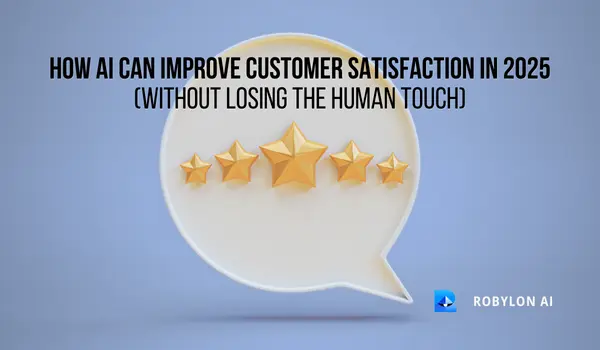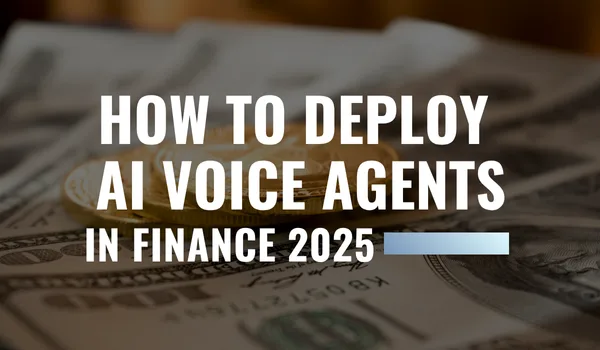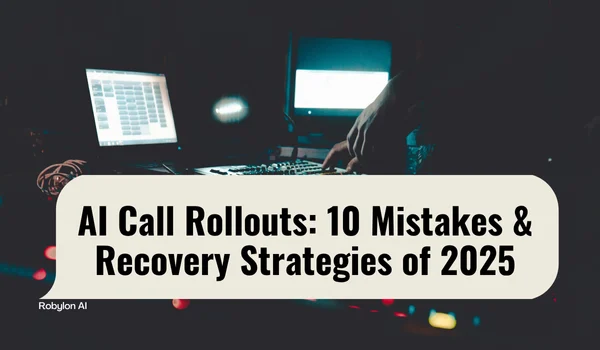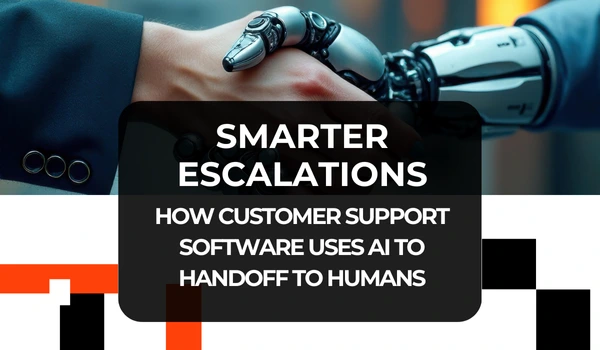TL;DR | Enterprise Outreach 2.0: AI Calling for B2B Sales
Companies now use Conversational AI and AI voice agents to automate and improve outbound conversations at enterprise scale. These AI-powered sales calls personalize openings and offers with first-party data via deep CRM integration, while conversation intelligence scores intent, extracts objections, and triggers next best actions.
For enterprise outreach, the system dials in parallel, covers multiple time zones, and routes high-value prospects to humans, improving sales operations efficiency. Built-in guardrails enforce consent, Do-Not-Call handling, and regional policies for compliance.
The result is consistent messaging, higher connect and meeting rates, and a repeatable motion that scales from hundreds to hundreds of thousands of conversations per week.
Introduction
In today’s hyper-competitive B2B world, volume matters, but so does precision. What if your sales team could consistently reach more prospects, at the optimal times, with personalized scripts and without burning out or hiring a dozen extra SDRs?
That’s the promise of AI sales calls. Using Conversational AI and AI voice agents, enterprises can now automate outbound dialing with deep CRM data, capture objections in real time, and funnel only high-intent prospects to human reps. The advantages are immediate: higher connect rates, faster qualification, seamless handoffs, and dramatically cleaner data.
But AI is not magic; to truly transform enterprise outreach, you need guardrails, governance, and a strategy. In this post, we’ll explore how enterprise sales AI works, show you the ROI model, and dive into how Robylon could reshape voice AI in call centers.
Let’s move from theory to practical impact. Book a demo
What Are AI Sales Calling Agents and How They Work
AI sales calls are handled by voice agents that use Conversational AI to run outbound and inbound sales conversations at scale. These systems personalize openings with first-party data, apply conversation intelligence in real time, and write back outcomes through deep CRM integration. In enterprise outreach, they automate dialing, qualify leads, route high-value prospects to humans, and improve sales operations efficiency across regions and time zones.
Core components
1. Conversational AI and voice agents
Natural speech, turn-taking, context memory, slot-fill qualification, objection handling, and multilingual support for enterprise outreach.
2. Automated calling agents
Queue and target selection for AI outbound calling, parallel connect to raise live conversations, and compliance-aware pacing and retries.
3. Real-time call routing, analytics, sales workflow AI
Intent detection from conversation intelligence, skills-based routing to human representatives, outcome logging, summaries, and next-best actions, dashboards for call analytics and pipeline impact.
The flow
Intake lead → Predictive lead scoring → Dial → Call personalization → Log to CRM integration
- Intake lead: Capture from forms, events, lists, or product signals
- Predictive lead scoring: Rank with fit and intent; pick channel and time
- Dial: AI outbound calling initiates parallel connects with compliance checks
- Call personalization: AI voice agents in sales tailor openers and offers using account and CRM context
- Log to CRM integration: Save transcript, disposition, tasks, and next steps; trigger cadences and routing for AI calling for enterprise outreach
Why AI Sales Calls Are Transformative for Enterprise Outreach
Teams get reliable coverage, stronger first touches, and cleaner pipelines. Results show higher connect rates, faster qualification, and better conversion efficiency across markets.
Scale without bloat
- Parallel connect raises live conversations without adding headcount
- 24×7 coverage spans global time zones with language and accent options
- Proven AI cold calling at scale supports launches, renewals, and reactivation
Better conversations at the first touch
- Conversation intelligence detects intent, objections, and next steps in real time
- Dynamic scripts adapt to persona, segment, and live responses
- High-value leads route instantly to human representatives with context
- Call summaries, action items, and dispositions post back to CRM for faster follow-up
Data-tight operations
- Automatic notes, tasks, and follow-ups sync through deep CRM integration.
- Standardized outcomes create cleaner funnels and audit-ready records.
- Ops teams track connect rate, meeting rate, SQLs, and revenue impact with performance intelligence dashboards.
- The motion reduces leakage and improves sales operations efficiency across channels.
Use cases
- Upsell/Cross-sell: Targeted offers aligned to the account stage
- Renewals: Automated reminders reduce churn risk
- Event/Webinar: Fast confirmation and post-event follow-up
- Segmentation plays: Region, vertical, or tier-specific scripts
Curious to explore your options? Check the detailed article: Best AI Sales Agents of 2025.
ROI You Can See In Quarter One
Primary metrics to track
- Connect Rate: Live Connections ÷ Total Dials
- Meeting Rate: Booked Meetings ÷ Live Connections
- Pipeline Created: Total New Pipeline Value Sourced By AI Voice Agents And Representatives
- Win Rate: Closed-Won ÷ Qualified Opportunities
- Cost Per Opportunity: Total Program Cost ÷ Qualified Opportunities
- Cost Per Resolution (Support-Adjacent Teams): Total Program Cost ÷ Resolved Requests
- First Call Resolution (FCR): Resolved On First Touch ÷ Total Handled
- Transfer Rate: Hand-Offs To Humans ÷ Total Handled
- Average Handle Time (AHT): Talk + Wrap Time Per call
Outbound deliverability diagnostics: ASR (answer-seizure rate), ACD (average call duration), spam-label rate, CPS, post-dial delay, and branded-caller-ID coverage %. Tie improvements directly to connect and meeting rates.
How to interpret quarter-one results
- Use call analytics to segment by source, persona, and time window
- Track “first-touch to meeting” and “meeting to SQL” separately for clarity
- Monitor sales operations efficiency: fewer manual notes, faster routing, cleaner dispositions
- Publish a weekly dashboard for leaders with sales performance intelligence and trends
Implementation tips for fast ROI
From pilot to profit: The ROI of enterprise voice AI
- Start with one high-volume use case (events, renewals, or dormant leads)
- Enable parallel connection within compliance limits
- Push summaries and tasks to CRM on every call
- Review objections weekly and update dynamic scripts
Where AI Outbound Calling Beats Traditional Methods
Precision and coverage
- Predictive lead scoring picks the best contact, the best time, and the best channel
- Local-presence dialing lifts pick-ups while respecting time-zone windows
- Fewer no-shows from smarter scheduling and instant confirmations
- Always-on outreach with Voice AI keeps coverage steady across markets
Personalization at scale
- Profile-aware openers use CRM fields, past touches, and firmographics
- Language choice and tone match region and role
- Offer variants align with segment, stage, and pain points
- Smart cadence coordinates voice with email and SMS for higher reach
Hyper-realistic voice & multilingual cloning with brand-consistent tonality; A/B test voice profiles by region/segment for lift in pickups and meetings.
Real-World enterprise impact
- Lower CAC: Automation reduces manual effort while expanding coverage
- Higher Conversion Rates: Fast, relevant touches create more qualified opportunities
- Shorter Cycles: Instant routing and clear next steps compress lag
- Global Scalability: One engine runs multi-market campaigns without headcount spikes
- Continuous Optimization: Conversation intelligence improves scripts, timing, and targeting
Why AI beats manual dialing
- Forecasting Clarity: Integrated call analytics surface source, persona, and time-of-day impact
- Consistent Quality: Dynamic scripts and policy checks reduce variance
- Reliable Follow-Up: Tasks and reminders auto-post to CRM
- Governance Ready: Consent, suppression, and audit logs run by default
To prove uplift end-to-end, track the right AI call metrics across connect rate, talk time, meetings booked, and revenue per call.
Must-Have Features in Sales Call Tools
1. Core
- CRM integration, calendar, routing, dispositions: Sync contacts, activities, and outcomes in real time. Schedule meetings on calendars and utilize skills-based and round-robin routing. Standardize call dispositions for clean reporting.
- Conversation intelligence, objection handling, and summary to CRM: Transcribe calls, detect intent and objections, and suggest next actions. Auto-generate call notes and push summaries, tasks, and follow-ups to CRM.
2. Advanced
- Agentic AI for sales outreach with tools and APIs: Orchestrate actions during calls: fetch pricing, check inventory, update records, trigger cadences, and schedule follow-ups through secure APIs.
- AI sales automation + call integration across email, WhatsApp, SMS: Coordinate voice touches with compliant messaging. If a call is missed, send a tailored follow-up via the appropriate channel and adjust the cadence accordingly.
- Multilingual voice agents with tone control: Support regional languages, accents, and brand-aligned tone. Adjust formality and reading level by persona and market.
- Telephony & deliverability suite: Verified numbers, branded caller ID (CNAM/logo), spam-label monitoring/mitigation, STIR/SHAKEN alignment, CPS (calls/second) throttles, and batch-campaign caps to protect answer rates
- DTMF/IVR navigation: Agents can traverse phone trees and reach humans in complex menus
3. Governance
- Compliance (TCPA, GDPR): Enforce consent and Do-Not-Call, record disclosures where required. Maintain suppression lists, retention rules, and immutable logs. Provide granular roles and SSO.
- Trust & deployment options: Public Trust/Status page, SOC 2 Type II (or equivalent), and VPC deployment choices for regulated industries.
Limits, Risks, And How To Mitigate
When not to automate
- Prioritize humans for Tier-1 accounts, high-value renewals, and legal/bespoke pricing
- Hand off by deal size, persona, industry, and risk flags
- Use AI voice agents for first-touch/reactivation; escalate when intent/complexity exceeds policy.
- Document exceptions & SLAs to keep outreach predictable.
Quality guardrails
- Run weekly reviews on transcripts and outcomes
- Add fact/price/eligibility checks and policy language validation
- Enforce brand style/tone with persona-based openers
- Use conversation intelligence for objection handling and next-best actions
- Push summaries to CRM with evidence links for audit/coaching.
Compliance reviews and model oversight
- Enforce TCPA/GDPR: consent, DNC, locale disclosures.
- Maintain suppression lists, retention rules, immutable audits.
- Gate sensitive actions via RBAC/SSO/approvals.
- Version scripts/models; pre-prod test edge cases & protected attributes.
- Monitor latency/errors/transfer causes; fallback to humans on risk.
- Human-in-the-loop (HITL): on low confidence, escalate sub-second while keeping continuity; log reason/outcome.
Risk-to-mitigation
- AI calling risks/limits → Policy gates, scripted disclosures, human fallback
- Replace SDRs? → No; use AI for volume, humans for strategy
- Consent/fairness/accuracy → Reviews, audits, red-team tests
- TCPA/GDPR → Automated checks, proof logs, localized disclosure
Before launch, review the most common failure modes and fixes in our guide: 10 AI Call Rollout Mistakes and How to Recover.
Use Cases By Function
1. New User Acquisition
- Prospecting at scale: AI sales outreach runs AI-driven B2B sales calls to new accounts using firmographic filters and intent data
- Event follow-ups: Voice AI confirms interest, books meetings, and shares recap links
- Lead rewarming: Conversational AI re-engages stalled MQLs with call personalization from CRM integration and web activity
- Multilingual coverage: Multilingual AI adapts voice, tone, and scripts by region for first-touch effectiveness
2. Pipeline acceleration
- Stalled opps: AI voice agents detect blockers from transcripts, propose next steps, and route to owners with context
- Multi-threading: Parallel outreach to champions, buyers, and finance with role-specific messages
- Renewal saves: Term-based nudges, value reminders, and meeting setup for at-risk contracts
- Cadence sync: Calls trigger email/SMS steps; outcomes update stages and tasks automatically
3. Customer expansion
- Cross-sell / Upsell: Usage-based targeting; call personalization introduces relevant add-ons or higher tiers
- Adoption nudges: Feature education calls post-onboarding to lift activation and health scores
- NPS callbacks: AI voice agents schedule fix sessions for detractors and ask promoters for reviews or referrals
- Account health loops: Signals from support and product trigger timely outreach by Voice AI
- Speed-to-lead acceleration: detect high intent, auto-schedule, or warm-transfer in-flow to compress time-to-conversation and lift win rates.
Compliance And Ethics In AI Outbound Calling
Consent and identification
- Capture express consent with timestamp, source, campaign ID
- State caller identity and purpose upfront
- Honor DNC, opt-outs, and channel preferences
Recording rules
- Localize scripts for one-party vs two-party consent
- Offer no-record path; auto-pause on sensitive fields
Data minimization & purpose limitation
- Collect only required fields; redact PII/payment in transcripts.
- Set retention windows; auto-delete on expiry or request.
Privacy notices
- Link a clear privacy page in IVR/SMS
- Provide export and erasure workflows
Jurisdiction watch-outs
- TCPA (US): Consent for auto-dial/texts, DNC scrubs, time-of-day limits
- GDPR (EU/UK): lawful basis, DPIA for high-risk, SCCs for cross-border
- Sector add-ons: HIPAA/GLBA/PCI as applicable
Governance ops
- RBAC, SSO, audit trails, immutable logs
- Model change control with pre-prod tests and bias checks
Bottom line: AI sales calls can be compliant when consent, recording, data rights, and routing are enforced in both product and process.
Tools Landscape And Selection Matrix
How to compare vendors (evaluation axes)
- Languages & multilingual AI: Supported languages, accents, TTS/ASR quality, tone control
- Routing & orchestration: Skills-based rules, warm transfer, SLA timers, queue logic
- Analytics & insights: Real-time call analytics, coaching cues, objection tagging, pipeline impact
- Governance & security: Consent capture, DNC, redaction, RBAC/SSO, audit trails, compliance attestations
- APIs & integrations: CRM (Salesforce/HubSpot/Dynamics), MAP, data warehouse, webhooks, tools for agentic AI actions
- TCO: Licenses, telephony, implementation, success services, and ongoing operations
Shortlist vendors (top AI voice agents in 2025) using this matrix, then pressure-test your picks against real capabilities.
How Robylon Could Help Reshape Voice AI in Call Centers
Robylon is purpose-built for enterprise outreach, and here’s how it can move the needle
- End-to-end integration with Salesforce, HubSpot, and 40+ other platforms
- Robylon places built-in consent captures, DNC handling, recording disclosure, and locale-aware limits
- Dynamic escalation & fallback: Every handoff includes full context - CRM history, objection notes, sentiment cues, so the human sounds steeped in the conversation.
- Embedded conversation intelligence tracks which scripts, openers, and objection responses work best.
- With multilingual voice agents, branded text-to-speech in local dialects, and intelligent time-zone dialing (parallel connect)
In short: Robylon makes enterprise outreach 2.0 possible, automating the bulk of voice work while preserving brand voice, safety, and human nuance.
Conclusion
The future of B2B outreach is not more dialing, it is smarter dialing. AI sales calls and voice agents allow enterprises to scale their outbound motion without multiplying headcount. You reclaim hundreds of hours per rep per year, compress qualification times, and drive cleaner pipelines.
But the real win is consistency. With built-in governance, logging, and seamless CRM handoffs, AI becomes a precise, auditable engine rather than a black box. The hybrid model, AI doing volume, humans doing nuance, is the sweet spot.
Book a demo to see Robylon Voice in action; AI sales calls that book meetings while reps focus on closing.
FAQs
What features to look for in AI sales call tools?
Prioritize accurate ASR/TTS, strong NLU, predictive/parallel dialing, calendar booking, and native CRM write-back. Add multilingual voices, skills-based routing, analytics, and real-time summaries. For governance, require TCPA/GDPR controls, DNC management, redaction, RBAC/SSO, and audit trails. If you are planning the AI sales calls, ensure APIs for agentic AI for sales outreach and orchestration across channels.
How does AI improve call personalization at scale?
Agents pull first-party data via CRM integration to tailor openers, value props, and next steps. Conversation intelligence detects intent and objections live, while AI parallel dialing in sales reaches buyers at the best times. Across channels, AI sales outreach syncs follow-ups (voice/email/SMS) so every touch feels relevant personalization that scales without sacrificing brand tone or governance.
Are AI sales calls compliant with TCPA and GDPR?
Yes, when governance is built in. Enforce caller ID, consent, time-of-day windows, and instant opt-outs for TCPA; define lawful basis, data minimization, and retention controls for GDPR. Keep Do-Not-Call lists, disclosures, and immutable logs. Modern enterprise outreach platforms pair automation with policy engines so AI-powered sales calls remain compliant and fully auditable across regions.
What is the ROI of AI-powered sales calls?
Model ROI simply: (Hours saved × blended SDR rate) + (Extra meetings × win rate × ACV) − platform cost
Savings come from less manual dialing and wrap-up; gains come from higher meetings via AI cold calling at scale and better follow-through. Add proof with call analytics (connect rate, meeting rate, AHT) to show how AI improves sales call efficiency quarter over quarter.
Can AI calls replace human SDRs?
Full replacement isn’t the goal; a hybrid model wins. AI outbound calling agents cover parallel dialing, qualification, and notes; humans lead discovery, negotiation, and relationship-building. This “agentic copilot” approach raises coverage and quality simultaneously. In practice, AI calling for enterprise outreach fills calendars with qualified meetings while SDRs and AEs focus on complex conversations that close revenue.
How do AI voice agents transform sales outreach?
They automate first-touch dialing, retries, and summaries while routing hot prospects to humans. Using AI sales automation + call integration, agents coordinate voice, email, and SMS, lifting connect and meeting rates. For enterprise sales AI, this creates a repeatable motion: AI-driven B2B sales calls handle volume, humans handle nuance; accelerating pipeline and improving forecasting accuracy across markets and time zones.
What are AI sales calls, and how do they work?
AI sales calls use AI voice agents in sales to place and manage conversations end-to-end. Speech recognition transcribes, NLU interprets intent, and text-to-speech replies in real time. With CRM integration, the agent personalizes the opener, qualifies interest, and logs outcomes. This blends AI outbound calling with conversation intelligence, producing consistent, auditable touches that scale across enterprise outreach without adding headcount.







.png)



.webp)














